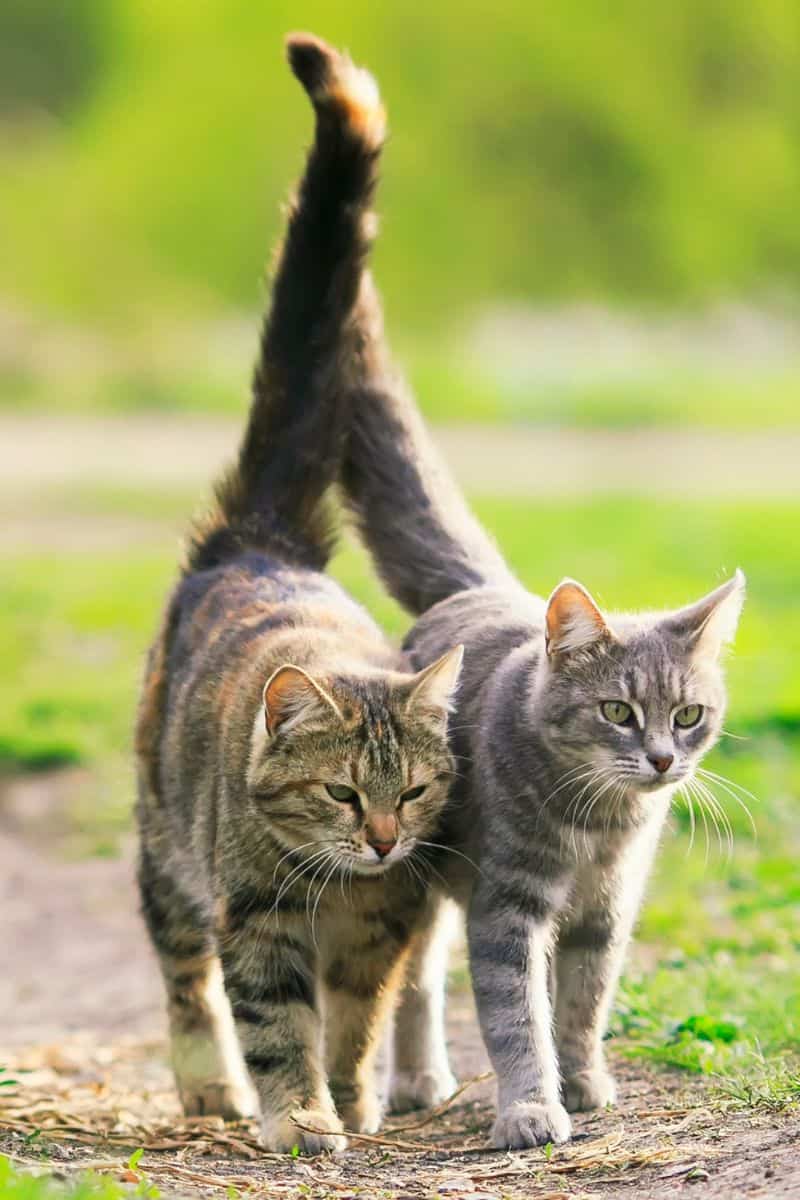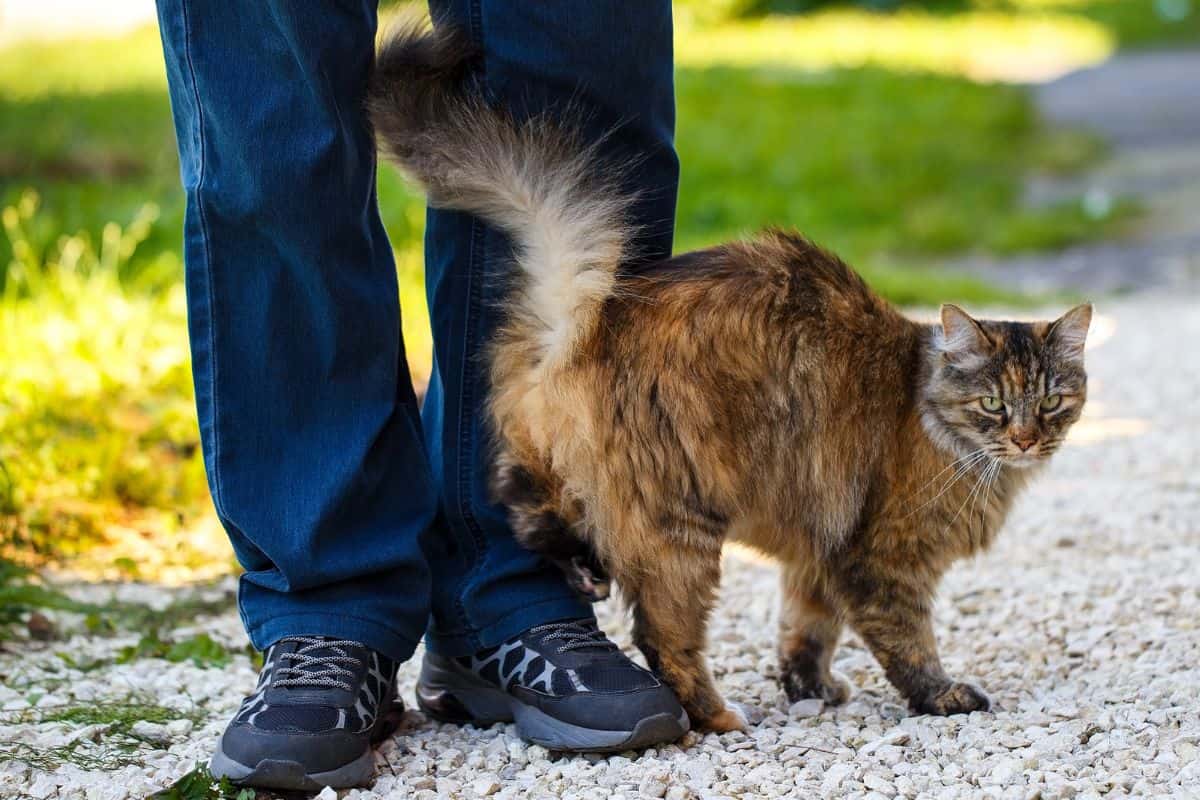One of the ways cats communicate with us and with other cats is through their tails. A cat’s tail is a highly expressive part of their body, and it can convey a wide range of emotions and intentions.
When it comes to showing affection, a cat’s tail can reveal a lot about how they are feeling and what they are trying to communicate.
In this article, we’ll explore some of the different ways that cats use their tails to show affection, as well as the meanings behind these behaviors.
Tail Puffing
One of the most distinctive ways that cats show affection with their tails is by puffing them up.
When a cat puffs out their tail, it often indicates that they are feeling happy, excited, or playful. This behavior is sometimes referred to as “bottlebrushing” because the tail resembles a bottle brush with the bristles sticking out in all directions.

If you’ve ever seen a cat chasing a toy or playing with another cat, you may have noticed their tail puffing up with excitement. This is a clear sign that they are enjoying themselves and having fun.
Similarly, when a cat greets their owner or another cat that they are fond of, they may puff up their tail to show that they are happy to see them.
Tail Twining or Wrapping
Another way that cats show affection through their tails is by twining or wrapping them around other objects or animals.
When a cat wraps their tail around a person, another cat, or even an inanimate object like a toy, it’s often a sign that they feel safe and comfortable. This behavior can be a way for cats to establish a sense of security and reassurance in their surroundings.

For example, if a cat is in a new environment or meeting a new person or animal for the first time, they may twine their tail around their owner’s leg or a nearby object to help them feel more at ease. Similarly, if a cat is snuggled up next to their owner on the couch, they may twine their tail around their owner’s arm or leg as a way to bond and feel close.
Cats also use their tails to show affection by wrapping them around other cats. This behavior can be a way for cats to bond and establish a sense of trust and companionship. When one cat wraps their tail around another, it’s often a sign of comfort and relaxation.
For example, if two cats are sleeping together or cuddled up next to each other, they may wrap their tails around each other as a way to feel closer and more connected. Similarly, if one cat is feeling anxious or stressed, they may seek comfort by wrapping their tail around another cat to help them feel more secure.
Tail Rubbing
Finally, cats may show affection through tail rubbing. When a cat rubs their tail against another cat, a person, or an object, it’s often a sign of friendliness and bonding. This behavior can be a way for cats to exchange scents and establish a sense of familiarity and comfort.

For example, if a cat rubs their tail against their owner’s leg, it can be a sign that they feel safe and comfortable in their presence. Similarly, if two cats are greeting each other for the first time, they may rub their tails together as a way to get to know each other and establish a sense of trust.
When a cat’s tail shows mixed emotions
Tail Lashing
While many tail behaviors are associated with affection, there are also some that can indicate negative emotions such as fear or anger. One of these behaviors is tail lashing, which occurs when a cat rapidly moves their tail back and forth. This behavior can be a sign of frustration, aggression, or anxiety.
However, tail lashing can also be a way for cats to communicate their needs and seek affection from their owners. For example, if a cat is feeling anxious or scared, they may lash their tail as a way to signal that they need comfort and reassurance.
If you notice your cat lashing their tail, it’s important to pay attention to their other body language and determine what they are trying to communicate.
Tail Twitching
Another behavior that can indicate mixed emotions is tail twitching. This behavior is similar to tail lashing but is less intense and can be a sign of both positive and negative emotions.
When a cat twitches their tail, it can be a sign of excitement, anticipation, or interest. However, it canalso be a sign of anxiety, annoyance, or agitation.
For example, if a cat is watching a bird outside the window, they may twitch their tail with excitement and anticipation. On the other hand, if a cat is being bothered by another cat or a loud noise, they may twitch their tail with annoyance or agitation.
It’s important to pay attention to your cat’s other body language and the context of the situation to determine the meaning behind their tail twitching.
Read the tail
From tail puffing to twining to rubbing, cats use their tails in a variety of ways to express their affection and establish bonds with those around them.
By paying attention to your cat’s tail behavior and other body language, you can gain a deeper understanding of their emotions and build a stronger, more fulfilling relationship with them.
References
Albright, J. D., Calder, C., & Learn, A. (2022). Introduction to Cat Behavior. Animal Behavior for Shelter Veterinarians and Staff, 30-52. https://doi.org/10.1002/9781119618515.ch2
Crowell-Davis, S. L. (2007). Cat behaviour: social organization, communication and development. The welfare of cats, 1-22. https://link.springer.com/chapter/10.1007/978-1-4020-3227-1_1
Crowell-Davis, S. L., Curtis, T. M., & Knowles, R. J. (2004). Social organization in the cat: a modern understanding. Journal of feline medicine and surgery, 6(1), 19-28. https://journals.sagepub.com/doi/pdf/10.1016/j.jfms.2003.09.013






